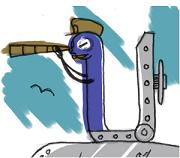Thai is a remarkably easy language. It’s only classed as a difficult language because it is usually taught in a very complicated manner.
The reason why Thai is so easy is because it is logical and consistent (unlike English, which is probably the most inconsistent and complicated language in the world). The grammar is as simple as can be (unlike French or German). The writing system is 100% phonetic (unlike English or Chinese): every letter has only one sound.
So what about the tones you might ask? Many words have different meanings if you pronounce them with a different tone – but we have tones in English, and it isn’t always so easy to tell what your meaning is in English if you vary the tone. Right?
Right!
The tones are kinda important in that you need to vary the tone where expected otherwise you the listener will be taken aback and have to ask “come again…?” But in normal (fast), colloquial speech, words are mostly all run together in a kind of monotone and only a few important words – and the ending of a phrase – needs to be sounded out with the correct tone.
Learning to Read Thai is Even Easier with the Rapid Method!
In the Rapid Method, we separate out the letters and their sounds from the tones in a two-step process. Learn all the letters first. You can easily learn the Thai alphabet in a day, but that isn’t enough to be able to read Thai. There’s a lot more involved, such as how the vowels are positioned (surrounding the consonant letter, not following each consonant in a left-to-right manner as in English), whether to fuse two letters together (as in “prayer”) or pronounce them separately (as in “pariah”) and how to separate out words when they are written without spaces in-between.
Once you can sound out each word accurately, then you learn how to figure out the tone for each word. You are expected to repeat the course, but this time adding in the tone. After doing this many times, you develop a kind of mental shorthand or dexterity and it becomes automatic and almost immediate.
And – a bit like learning to drive where everything seems so complicated and up in the air at first – it becomes very easy. It turns out that tones are the easiest and least signficiant part of the Thai language!
 Click here to buy (opens in a separate window – please close afterwards)
Click here to buy (opens in a separate window – please close afterwards)
The Rapid Method’s Magic
The ‘Rapid Method’ simplifies the language to only what you need to know, so no learning the Thai alphabet, Ko Kai, Do Dek, etc. You will learn to ‘see’ the shapes and ‘solve the puzzle’ for each word.
 |
The “D” sound Doubled over himself, and the”B” sound a U as in “U-Boat” (or “Unterseeboot” if you’re German). |
 |
Each letter has a personality based on its ‘sex’, which is either boy, girl or ladyboy! This only matters much later, when you learn how to work out the tones for each word. This bizarre way identifying the letters actually makes tones a doddle.
I am very busy and, besides, Thai is an obscure language compared with Chinese or Spanish… and I can get by and work or manage my business in Thailand successfully enough without knowing more than a smattering of Thai.
Many people feel this way, and they are right. It’s not essential to know Thai to be able to live and work here comfortably and successfully. Nevertheless, I think it is more useful than you would expect to be able to communicate in Thai if you want to live and work here. I’ve researched the most effective ways of learning a language – with the busy person in mind. I realize that we are all busy with work, family, sports/entertainment and a hectic social life. Devoting time to ‘studying’ is a pretty low priority for most of us (and I include myself).
So my approach is to find ways of learning Thai that requires very little time and effort. I’ve discovered that learning to read is the most important first step. If you attend one of my Read Thai bootcamps then it can be done and dusted in a week.
This then leads on to being able to absorb Thai effortlessly from the environment, the ‘living dictionary’ that surrounds us.
Although it seems counter-intuitive, if you want to be able to speak and communicate then the quickest and most efficient way is through reading… along with listening practice and speech training.
More about this in the follow-on 30-week Everyday Thai for Beginners course and the 50-lesson, one-year Rapid Fluency Course…
*Although being ‘fluent’ can quickly develop into mastering the language at a high level, it does not necessarily mean that you will be capable of advanced and academically correct usage of the language. I define ‘fluency’ to mean being able to read and understand people and communicate effortlessly at normal speed without thinking about it.
